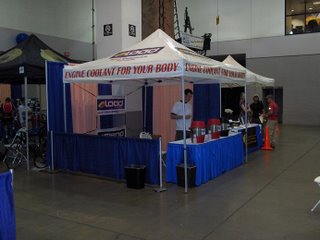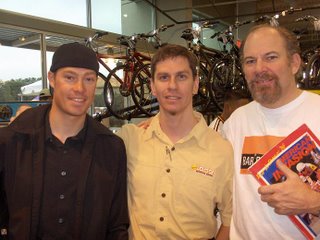By Dr. Stephen Cheung, Ph.D.PezCycling News
October 23, 2006
Back in the good old days of sports drink design, life was relatively simple and the main things to manipulate were carbohydrates and electrolytes. In recent years, a new kid on the sports drink block arrived in the form of proteins. We look at two new studies that re-examine the use of proteins in sport drinks.
The Gatorade daysLife was simple in the old days for pro cyclists. Most riders simply had water in their bottles and maybe some de-fizzed Coke near the end of races. Of course, the stars would supplement such simple fare by getting their domestiques to raid local taverns for vino every so often.
Everything changed, of course, with the introduction of Gatorade in the 70's, the first sports drink specifically designed for athletic competition and featuring a mix of carbohydrates and electrolytes (i.e., salts). Basically, the theory went that you're losing a lot of salt in sweat and burning up carbohydrates as a major and finite fuel source, so those were the important things to replace in a sports drink.
Since that time, scientific studies have helped to develop an overall consensus of six to eight percent carbohydrate being the optimal concentration, along with a moderate amount of electrolytes, mainly sodium.
The case for proteinWithin the last five years or so, however, the established formula for the majority of sports drinks changed, with some research advancing the benefits of adding protein into sports drinks. The study that made the really big splash was one by Saunders et al. (2), which compared a commercially available carbohydrate-protein sports drink (reading between the lines, it was Accelerade) with the same carbohydrate content worth of Gatorade (such that the Accelerade had greater total calories).
Having two drinks with different total calories may seem like a weakness in the design, as it might be advantageous simply to have more calories regardless of source. However, as mentioned above, scientific consensus suggest that the ceiling for carbohydrate absorption is already reached at the six to eight percent concentration, so simply adding more carbohydrates is not going to get more into your system and may even slow things down in the digestive tract. In contrast, think of protein as a back-door way to cram more calories into your system.
With a 75 percent and 85 percent VO2max ride to exhaustion protocol (where subjects are asked to ride at a set workload for as long as possible), Saunders et al. (2) found huge increases in exercise time (29 percent and 45 percent increases at 75 and 85 percent VO2max, respectively).
This, to put it bluntly, is huge in a field where 10 percent improvement is considered astronomical. However, the study was not able to ascertain exactly whether this huge benefit came about due to the extra calories or to something specific to the addition of proteins. Regardless, it certainly had many companies jumping on the bandwagon of adding and touting proteins in their sports drinks.
Re-testing proteinThe scientific process works nicely in continually testing and re-testing theories, no matter how well-established. In the August 2006 issue of the same Med Sci Sports Exerc journal, van Essen and Gibala (3) tested a similar two types of drinks (six percent carbohydrates and six percent carbohydrates + two percent whey protein) and also a placebo.
One nice touch was that the drink powder was all produced by the same source to be as identical in aesthetics (taste, colour, etc.) as possible, rather than two different commercial sports drinks. Subjects were also required to drink at a much higher and realistic rate (250 mL every 15 min, near the maximal absorption rate for fluid by the digestive tract) than in the Saunders et al. study (~125 mL every 15 min for a 70 kg rider).
A further modification to the study design by van Essen and Gibala was the use of an 80 km "time trial" protocol (where subjects are asked to complete the ride as fast as possible with no pacing/timing cues) rather than the "ride to exhaustion" protocol of Saunders et al. (2).
This was done on the grounds that a time trial is much more applied and realistic, and I certainly concur. Indeed, there has been a general trend towards moving away from the "ride to exhaustion" style of testing, due to its high variability from motivational factors and also simply across people. Indeed, one of my own very first published papers back in 1995 (kinda sad to say, but also one of my most famous even to this day!) detailed exactly this huge variability (1) and concluded that it was largely useless if it was the only parameter determining "success".
Other notes on the protocol:Subjects were trained but not super-elite cyclists, 24 yr. old on average with a VO2max of 63 mL/kg/min.
Test of 80 km was chosen to be long enough that glycogen stores would be significantly depleted and the ingested calories would really come into play.
Basic factsSo with these modifications, what did van Essen and Gibala find? Both carbohydrates (135 min +/- 9 min) and carbohydrates + protein (135 min +/- 9 min) had faster completion times than placebo (144 min +/- 10 min), but there were no differences between the two carbohydrate drinks.
Comparison shoppingSo two studies using pretty similar composition carbohydrate and carbohydrate-protein drinks have come up with dramatically different findings. How to pick and choose between them? Here are some of my thoughts:
Overall, I have to give the nod to the van Essen and Gibala study for being more well-controlled and realistic.
The rate of fluid ingestion may be one of the major reasons for the difference between the two studies. Remember that the Saunders et al. study had a relatively low (500 mL/h) drinking rate for a 70 kg individual, resulting in about 37 g/h of carbohydrate replacement. This is much lower than the 60 g/h recommended to maximize carbohydrate replacement in the body. Therefore, it may be the case that the extra protein only plays an important role when there's less-than-optimal carbohydrate replacement.
So what does this mean for you and me? The best sports drink is the one that you'll drink the most of! Experiment with different sports drinks and see what tastes bests and sits best in your stomach, and then use it!
One final noteThe final interesting observation from the van Essen and Gibala study? The 80 km was done as 4x20 km laps on a stationary trainer. In both the carbohydrate and carbohydrate + protein conditions, the first 20 km was done at a faster average pace than the placebo, even though glycogen stores wouldn't have really become depleted yet. This phenomenon of early benefit from carbohydrate ingestion supports similar incidental findings in other studies.
One proposal is that pacing is done by a "smart sensor" in the brain somewhere that integrates input from throughout the body, and that the presence of carbohydrates triggers sensors in the mouth, relaying "positive" information to the brain and enabling it to select a higher pace. So sports drinks can be useful even in short and hard interval rides rather than only for long rides!
ReferencesMcLellan TM, Cheung SS, and Jacobs I. Variability of time to exhaustion during submaximal exercise. Can J Appl Physiol 20: 39-51, 1995.
Saunders MJ, Kane MD, and Todd MK. Effects of a carbohydrate-protein beverage on cycling endurance and muscle damage. Med Sci Sports Exerc 36: 1233-1238, 2004.
van Essen M and Gibala MJ. Failure of protein to improve time trial performance when added to a sports drink. Med Sci Sports Exerc 38: 1476-1483, 2006.Stephen Cheung is an associate professor of Kinesiology at Dalhousie University in Halifax, Nova Scotia, Canada, and his athletic ability is beyond assistance from any ergogenic aid known to humans! Stephen's company, Podium Performance, also provides elite sport science and training support to provincial and national-level athletes in a number of sports. He can be reached for comments or coaching inquiries at
stephen@pezcyclingnews.com.



